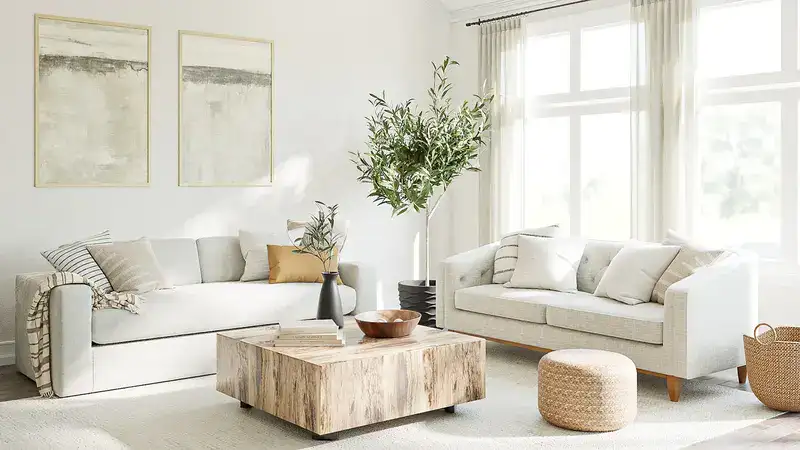Introduction to Japandi Style
In the world of interior design, Japandi style has emerged as a timeless and elegant trend. Combining the best elements of Japanese minimalism and Scandinavian functionality, Japandi creates spaces that are serene, warm, and effortlessly stylish. It’s a design philosophy that values simplicity, craftsmanship, and natural beauty, encouraging a lifestyle of mindfulness and calm.
The Origins of Japandi
The term “Japandi” merges “Japanese” and “Scandinavian,” symbolizing the seamless fusion of these two design traditions. Japanese aesthetics focus on simplicity, natural materials, and the concept of “wabi-sabi,” or the beauty found in imperfection. Meanwhile, Scandinavian design, known for its functionality and coziness (“hygge”), emphasizes light, practicality, and clean lines. Together, they form a style that is both minimal and inviting, practical yet artistic.
Key Characteristics of Japandi Style
Minimalism with Warmth
At the heart of Japandi style is minimalism, but it’s never cold or sterile. Spaces are free of clutter, with only essential, purposeful items on display. However, the warmth of wood tones, textured fabrics, and soft lighting ensures that the atmosphere remains welcoming and comfortable.
Neutral and Natural Color Palette
Japandi interiors favor a subdued color scheme. Earthy tones like beige, soft gray, muted greens, terracotta, and off-white dominate the palette. Natural materials such as raw wood, stone, linen, and cotton are highlighted, enhancing the connection to nature.
Quality Over Quantity
Instead of filling a space with many items, Japandi promotes investing in fewer, but higher-quality pieces. Every piece of furniture or decor is carefully selected for its craftsmanship, durability, and beauty. This approach reflects both the Japanese respect for artisanship and the Scandinavian emphasis on functionality.
Clean Lines and Organic Forms
Furniture in Japandi interiors often features sleek, clean lines and low profiles. Yet, there is also a love for organic shapes — curved chairs, round tables, and asymmetrical décor elements — that soften the rigidity and add a layer of visual interest.
Designing a Japandi Interior
Choosing the Right Furniture
When selecting furniture, look for pieces that are low-slung, simple, and crafted from natural materials. A classic Japandi room might feature a low wooden platform bed, a minimalist sofa in neutral tones, and a simple dining table with lightweight chairs. Each piece should feel timeless rather than trendy.
Integrating Natural Elements
Plants are a key part of Japandi style. Opt for simple, sculptural greenery like bonsai trees, snake plants, or olive trees. Natural elements like stone bowls, woven baskets, and ceramics further ground the space in nature, offering texture without overwhelming the eye.
Embracing Light and Space
Japandi rooms often have an airy, spacious feel. Large windows, sheer curtains, and strategically placed mirrors help to maximize natural light. Negative space — the empty areas between furniture and decor — is intentionally preserved to give the room breathing room.
Mixing Textures Thoughtfully
Though the color scheme is restrained, Japandi spaces play with texture to create depth. Think of soft wool rugs paired with smooth wooden floors, or a linen couch contrasted with a sleek stone coffee table. Layers of tactile materials make the room feel cozy yet uncluttered.
Japandi Accessories and Decor
Art and Wall Decorations
Art in a Japandi home tends to be minimal and meaningful. Abstract prints, traditional Japanese ink paintings, or Scandinavian-inspired sketches fit beautifully. Frames are kept simple and in neutral colors to maintain harmony.
Lighting Choices
Lighting in Japandi interiors is subtle and layered. Paper lanterns, minimalist floor lamps, and pendant lights made from natural materials like bamboo or rattan are popular choices. Warm white bulbs are essential to create a soft, welcoming glow.
Functional Decor
Decor items serve a purpose beyond beauty. Storage solutions like open shelving, woven baskets, and modular units help maintain the clean, uncluttered look. Even everyday items like teapots, vases, and cushions are chosen for their aesthetic appeal.
The Philosophy Behind Japandi
Beyond aesthetics, Japandi is a philosophy of living. It encourages intentionality, mindfulness, and a deep appreciation for the everyday. By surrounding ourselves with beauty and functionality, we create a home that nurtures our wellbeing. In a world full of noise and chaos, Japandi offers a retreat — a space to breathe, think, and simply be.
Why Japandi Style Is So Popular
The growing popularity of Japandi style speaks to a universal desire for calm and simplicity. As lives become busier and technology more pervasive, people crave homes that offer peace. Japandi’s emphasis on craftsmanship, sustainability, and authenticity aligns perfectly with modern values, making it more than just a design trend — it’s a lifestyle choice.
Final Thoughts
Japandi style captures the soul of two cultures that deeply value beauty, functionality, and simplicity. By embracing its principles, you can transform your home into a sanctuary of calm and timeless elegance. Whether you live in a bustling city apartment or a countryside house, Japandi’s serene, balanced approach can make any space feel like home.
> For more information link to click
